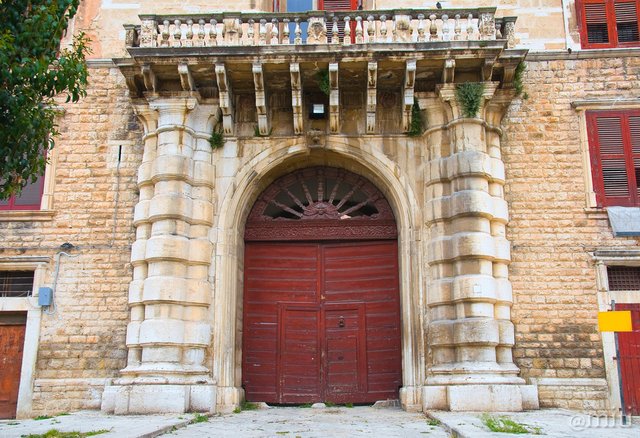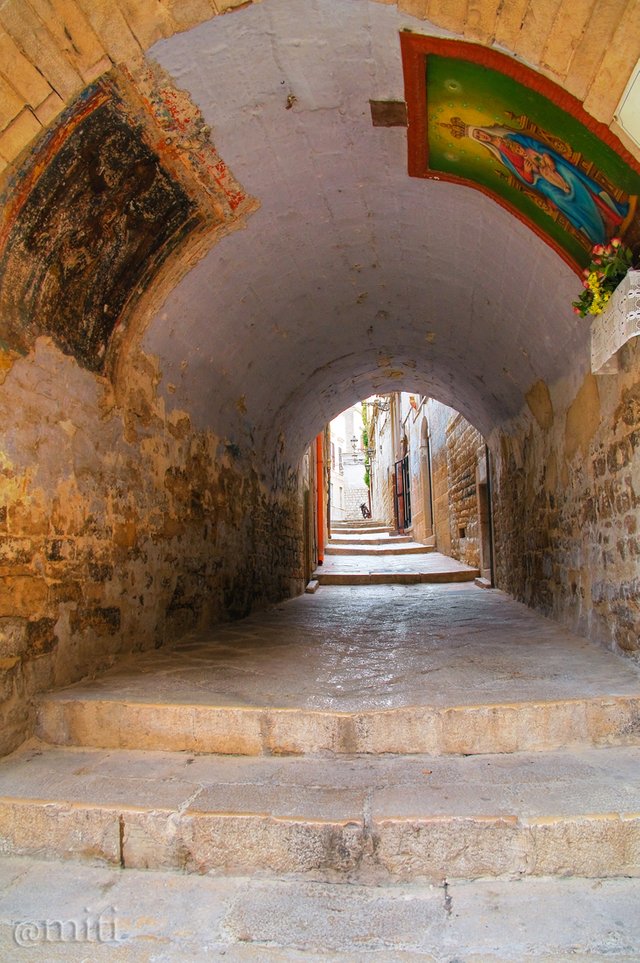A Journey through Italy: one photo every day #130 - ANDRIA [ENG/ITA]

The Ducal Palace (Author's photo - All rights reserved)
Il Palazzo Ducale (Immagine dell'autore - tutti i diritti sono riservati)



Ciao a tutti,
questo è un viaggio attraverso l'Italia. Posterò una foto al giorno con una brevissima descrizione. Spero vi piaccia!

Andria è una città nella provincia della BAT (Barletta-Andria-Trani), nella regione meridionale italiana della Puglia. È la città più importante di questo territorio conosciuta come "Puglia Imperiale". La Puglia Imperiale è un insieme di miti e leggende, cavalieri e crociate, e soprattutto castelli, la magnifica eredità lasciata in questa terra dall'imperatore Federico II di Svevia.
Andros è il nome che il mitico eroe Diomede (Tideo) ha dato alla città da lui fondata, ma Andria ha probabilmente origini multiple: greca con il nome di Netion, o apostolica a causa della presenza sul suo territorio di Sant'Andrea.
Sicuramente durante l'epoca romana, Andria collegò il suo sviluppo alla presenza della Via Traiana e della vicina e più influente Trani.
Dopo le invasioni barbariche (V secolo dC) e quella del regno ostrogoto (476-535), Andria, come tutta la Puglia, passò nelle mani bizantine e divenne sede principale della comunità monaca basiliana, nota come Andre.
Nel 1046 la città fu sotto il regno di Pietro il Normanno e divenne "Civitas", fortificata con una cerchia di mura e 12 torri di avvistamento. Andria divenne Ghibellina nel 1200 ed era fedele a Federico II di Svevia. Nel 1350 e nel 1370 subì due assalti, il primo dei quali, per mano dei mercenari longobardi e tedeschi, fu particolarmente dannoso. Nel 1487 la città cadde sotto il regno degli Aragonesi e fu testimone di un periodo pieno di battaglie.
Nel 1552, Andria fu consegnata alla famiglia Carafa, sotto la quale rimase fino all'avvento delle Campagne italiane di Napoleone (1799).
Non a caso il Sacro Romano Imperatore Federico II di Svevia decise di costruire la sua casa più importante vicino ad Andria: la suo amata "Andria Fidelis" l'aveva già stregata con il suo fascino enigmatico.
Il centro storico della piccola città è un labirinto di antiche strade tortuose e viuzze minuscole, edicole votive, dettagli architettonici, stemmi familiari splendidamente scolpiti raccontano le storie delle famiglie nobili medioevali che vivevano qui e la mistica bellezza degli antichi santuari è testamento della fede autentica della popolazione nel corso dei secoli.
Tra tutte le meraviglie di Andria, regna un esempio supremo: il magnifico Castel del Monte, che per secoli ha affascinato il mondo con i suoi leggendari misteri. L'imperatore Federico II, noto anche come il Puer Apuliae (figlio di Puglia) fece costruire il castello come simbolo di perfezione, costruendolo nella città che amava.
In Andria si può visitare la Cattedrale di Santa Maria Assunta (del XII Secolo) con la sua cripta del 7° secolo appartenente al precedente edificio di epoca altomedievale, dove sono conservate le spoglie di Isabella d'Inghilterra e Jolanda di Brienne, mogli dell'imperatore Federico II di Svevia.
Ci sono molte altre testimonianze religiose e architettoniche romaniche nella città, tra cui: la Chiesa di Sant'Agostino (del XIII secolo) che fu costruita dai Cavalieri Teutonici, le Chiese di S. Croce (X secolo), S. Nicola , la Chiesa di San Francesco con il suo Chiostro (XII secolo).
A parte il Palazzo Ducale (restaurato dalla famiglia Carafa nel XVI secolo), i turisti devono essere sicuri di non perdere il Palazzo Vescovile.
Cosa vedere: il Centro storico, il Palazzo Ducale, Castel del Monte, la Cattedrale di Santa Maria Assunta, la Chiesa di Sant'Agostino, la Chiesa di S. Croce, la Chiesa di S. Nicola, la Chiesa di San Francesco e il Chiostro, il Palazzo Vescovile, il Museo del confetto, la Chiesa di Santa Maria "Vetere", la Chiesa di San Domenico, il Museo Diocesano, il Santuario della Madonna dell'Altomare, la Chiesa di Sant'Angelo De 'Meli, il Santuario di Nostra Signora dei Miracoli.

Hello everyone,
I began a Photo Journey through Italy. I will post one photo every day with a little note of explanation. I hope you like it!

Andria is a city in the province of BAT (Barletta-Andria-Trani), in the southern Italian region of Puglia. It is the most important city in this territory known as “Puglia Imperiale”. Puglia Imperiale is a tapestry of myth and legend, knights and crusades, and above all castles, the magnificent heritage left to this land by the Emperor Federico II of Swabia.
Andros is the name that the mythical hero Diomedes (Tideo) gave to the city he founded, but Andria probably has multiple origins: Greek by the name of Netion, or apostolic due to the presence on its territory of Saint Andrea.
Definitely during Roman times, Andria linked its development to the presence of Via Traiana and the nearby and more influential Trani.
After the Barbaric invasions (5th Century AD) and that of the Ostrogoth Reign (476-535), Andria, as with all of Puglia, passed into Byzantine hands and became a main seat for the Basilian Monk Community, known as Andre.
In 1046 the city was under the reign of Peter the Norman and became “civitas”, fortified with a circle of walls and 12 watchtowers. Andria became Ghibelline in 1200 and was faithful to Frederick II of Swabia. In 1350 and 1370 it suffered two assaults, the first of which, at the hands of Lombard and German mercenaries, was particularly damaging. In 1487 the city fell under the reign of the Aragonese, and witnessed a period filled with battles.
In 1552, Andria was handed over to the Carafa Family, under which it remained until the advent of the Napoleonic Italian Campaigns (1799).
It was no accident that the Holy Roman Emperor Federico II of Swabia decided to construct his most important home near Andria: his beloved “Andria Fidelis” had already bewitched him with its enigmatic charm.
The historical center of the little city is a maze of ancient winding streets and tiny lanes, votive niches, architectural details, beautifully carved family crests recount the stories of the noble Medieval families that lived here, and the mystical beauty of the ancient shrines are testament of the authentic faith of the population over the centuries.
Of all the wonders in Andria, one reigns supreme: the magnificent Castel del Monte, which for centuries has fascinated the world with its legendary mysteries. Emperor Federico II, also known as the Puer Apuliae (Son of Puglia) had the castle built as a symbol of perfection, constructing it here in the city that he loved.
In Andria on can visit the Cathedral of Santa Maria Assunta (Assumption Cathedral – 12th Century) with its 7th Century Crypt belonging to the previous High Medieval period building, where the remains of Isabella of England and Jolanda of Brienne, wives of the Emperor Federick II of Swabia are kept.
There are many other Romanesque architectural religious testimonies in the City, amongst which: the Church of Sant'Agostino (Saint Augustine – 13th Century) which was constructed by the Teutonic Knights, the Church of S. Croce (10th Century), S. Nicola, the Church of Saint Frances and the Cloister (12th Century).
Apart from the Palazzo Ducale (restored by the Carafa Family during the 16th Century), tourists must be sure not to miss the Palazzo Vescovile (Episcopal Building).
Thing to see: the Historical centre, the Ducal Palace, Castel del Monte, the Cathedral of Santa Maria Assunta, the Church of Saint Augustine, the Church of S. Croce, the Church of S. Nicola, the Church of Saint Frances and the Cloister, the Episcopal Building, the Museum of the Sugared Almond, the Church of Saint Mary “Vetere”, the Church of Saint Dominic, the Diocesan Museum, the Sanctuary of the Madonna dell’Altomare, the Church of Saint Angel De’ Meli, the Sanctuary of Our Lady of Miracles.

| Tipo di foto / Category | Paesaggio / Landscape view |
| Esposizione / Settings | 1/125 sec, ISO 280, f/9 |
| Camera | Nikon D5000 |
| Lente / Lens | Tamron SP 17-50mm f/2.8 XR Di II LD |
| Filtro / Filter | Polarizzatore Hoya / Hoya Polarizing filter |
| Cavalletto / Tripod | Manfrotto MKC3-P01 |
| Località / Location | Andria (BT), Italia |
| Software | Photoshop |


Alleyway in the historical center (Author's photo - All rights reserved)
Vicolo del centro storico (Immagine dell'autore - tutti i diritti sono riservati)
i love your posts
Looking nice place
Yes, it is!
Please remove your downvote my back comment please
Congratulations, Your Post Has Been Added To The Steemit Worldmap!
Author link: http://steemitworldmap.com?author=miti
Post link: http://steemitworldmap.com?post=a-journey-through-italy-one-photo-every-day-130-andria-eng-ita
Want to have your post on the map too?
nice post, great pic
You got a 39.76% upvote from @ocdb courtesy of @miti!
Chic article. I learned a lot of new things. I signed up and voted. I will be glad to mutual subscription))))
Really nice written post..
Posted using Partiko Android
Thank you!
I also want to visit Italy some day
Nice picture, I love the pillars next to the door. Andria (Italy) city that preserves its architectural beauty.
Yes, it has a great historical and cultural heritage.
Been dreaming to go to Italy and I think I will one of these days.
Then I wish you well.